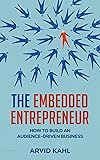Highlights from "The Embedded Entrepreneur"
By Arvid Kahl

Founders that go "idea-first" often build businesses that are "solutions looking for a problem." The “idea-first” approach results in products that are lacking validation and are built without a clear audience in mind.
An audience is everyone who should be interested in you, your business, and your products. They are not just walking wallets. An audience is a group of real people with desires, dreams, and problems. If you want to build an audience-first business, you will need to build honest and authentic relationships with actual human beings.
A community looks in all kinds of directions, but an audience looks at you. In a community, people show up because of each other and what they create together. In an audience, they show up because of you and what you create.
You first choose a market to operate in, find a potential audience to serve, embed yourself within their communities, and learn what you need to create to solve their critical problems. Then, and only then, do you work on your idea — and create a following along the way.
I call this the "entrepreneurial curse": we founders assume too much. At its very core, we need to assume that things will work out fine to find the motivation to start a business. That's the healthy part. But we then take it too far. We assume that we know our market, who our audience is, and what they need.
“Build it and they will come.” This approach is very risky.
Every day, a developer somewhere considers building another variation of an existing tool.
particularly when they come from an engineering background: they severely underestimate an audience's importance — with devastating consequences.
Museums have understood a core rule of a successful business: find your audience first, then sell them something they need. They think "audience-driven."
we assume that since we felt the need for a specific thing to exist, others will have the same need.
No business was ever successfully built by a founder who didn't care about the people they were selling their product to. You need to feel the desire to help your customers genuinely, or you will lose interest in providing value to them at some point.
Spend as much time as you need to figure out if an audience is big enough for your business.
There is a research methodology in the social sciences called "the ethnographic method," which is very similar to what we're planning to do here: the researcher joins a cultural setting, observes actively (by directly being part of the social activities), and passively (by surveying the actions of others from a distance), and then forms a narrative account of what they learned, contrasting it to an initial theoretical assumption.
Once you understand the jargon that people use and have interesting things to contribute, you should engage the community.
online communities usually attract people who just have to talk about the things they're interested in. It's a form of self-selection to join such a community: there is a minimum threshold of passion you need in order to be regularly active in such a community.